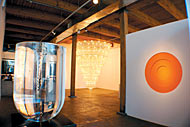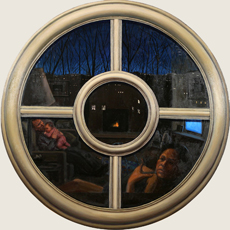Art in 2007: All Galleries Great and Small
By Justin Sondak in Arts & Entertainment on Dec 28, 2007 8:04PM
 This was a good year to be a large cultural institution. If cuts in state arts funding and unstable financial markets made a dent in Chicago’s largest museums, they sure weren’t letting on. The Art Institute remained one of the city’s prime attractions, attracting hordes of frugal visitors on free Thursday nights to piece together Richard Misrach’s disorienting beach photography and William Pope.L’s naïvely charming travelogue, or to enjoy Jeff Wall’s mind-bending photography — his mid-career retrospective was the year’s most breathtaking exhibit.
This was a good year to be a large cultural institution. If cuts in state arts funding and unstable financial markets made a dent in Chicago’s largest museums, they sure weren’t letting on. The Art Institute remained one of the city’s prime attractions, attracting hordes of frugal visitors on free Thursday nights to piece together Richard Misrach’s disorienting beach photography and William Pope.L’s naïvely charming travelogue, or to enjoy Jeff Wall’s mind-bending photography — his mid-career retrospective was the year’s most breathtaking exhibit.
The MCA added a 40th candle to their cake, hosting a fun but superficial look at rock and roll aesthetics and a festival of repackaged self-examination. Unfortunately they highlight reeled too often (though we heart their photography collection). Rudolph Stingel’s DIY aesthetic, featuring massive, graffitied walls and glowing carpet was the rare fresh moment for an institution spending much of the year on autopilot.
The National Museum of Mexican Art exhibited some of this year’s most challenging and rewarding work, including a celebration of Frida Kahlo and her contemporaries, and the Diálogo project, exposing domestic life’s contradictions. City curators went above and beyond for two Chicago Cultural Center exhibitions: a survey of contemporary art from and inspired by India, and pop iconoclast Karl Wirsum’s greatest hits. The History Museum rolled out a fitting tribute to Art Shay and gunned for a Chicago aesthetic, while the Spertus opened a beautiful new Krueck & Sexton-designed building to house some hip Hebe work.
A strong global arts market chasing the next big thing boosted the gallery scene. New additions to Pilsen, Bronzeville, West Town, and West Loop districts fed a slowing but still potent gentrification machine. Most important, the work displayed rarely let us down.
After the jump, a chronological look at our favorite gallery shows.
Africa Dot Com, Glass Curtain Gallery
New media and digitalized African rhythms complemented an understated photo essay of globalized, evolving tribal cultures. In life, art, and politics, are the boundaries ever clear? And why is our attention naturally drawn to the most unnatural part of the frame?
 The Last Seduction – A Welcome Surrender to Beauty, Carrie Secrist Gallery
The Last Seduction – A Welcome Surrender to Beauty, Carrie Secrist Gallery
Petroc Dragon Sesti’s "Event Horizon", a turbine-propelled whirpool of clear oil, was a hypnotic distraction to thousands of West Loopers, May Day marchers, and art lovers who needed another look. We were, as the title suggests, powerless to resist the sly, ironic charms of this collection, particularly Mark Ryden’s "Angel of Meat" and Al Weiwei’s resplendent "Chandelier."
Caleb Weintraub: We Must Go and Tell the King, Peter Miller Gallery
Putting his barbarian invaders in party masks and pre-pubescent visages, Weintraub pushes our post-9/11 paranoia toward the brink while appealing to our sense of irony. We were tempted to laugh off the glossy comic-book apocalypse and the toddlers toting heavy artillery, but seeing sensationally expressive, and adorable, children prematurely robbed of their innocence ultimately felt tragic. It was the biggest mindfuck of the gallery season.

Leeah Joo: Windows, Andrew Bae Gallery
We want what we’re convinced we can’t have, and Joo’s stunning oil paintings take full advantage of that truth. Her windows hold us back from mysterious (and gorgeous) scenes inspired by Alfred Hitchcock, Margaret Atwood, and Korean folktales.
 Vanishing Point: David Plowden, Catherine Edelman Gallery
Vanishing Point: David Plowden, Catherine Edelman Gallery
No disrespect to the Flickr-ites, but Plowden’s evocative shots of America’s once robust industrial landscape are the most compelling argument to continue working with film. The exhibit commemorated the IIT professor’s 50 years of capturing man-made work environments and small towns, each a monument to a gritty, largely lost lifestyle.